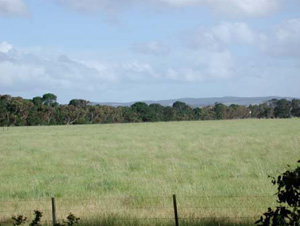CLRA47
|
| CLRA47 |  Eutrophic, Mesonatric, Brown Sodosol | |
| Winchelsea (Ingleby Road), Winchelsea district, south-west Victoria | |||
| Rises | |||
| Neogene Newer Volcanics: extrusive tholeiitic to alkaline basalts, minor scoria and ash | |||
| Lower slope | |||
| 3% | |||
| North-north-east | |||
Horizon | Depth (cm) | Description | ||
A1 | 0–5 | Dark greyish brown (10YR4/2); loam fine sandy; weak consistence (moderately moist); non-calcareous, pH 6.5; sharp boundary to: | ||
A2 | 5–25 | Brown (10YR5/3); sporadically bleached (10YR7/3; dry); silty clay loam; weak medium prismatic, parting to fine prismatic structure; rough ped fabric; weak consistence (moderately moist); non-calcareous, pH 6.5; clear boundary to: | ||
B21 | 25–45 | Dark brown (10YR4/3) with few medium faint yellowish brown and grey (10YR5/6, 10YR5/1) mottles; medium clay; strong medium prismatic, parting to medium and fine angular blocky structure; smooth ped fabric; strong consistence (moderately moist); non-calcareous, pH 6.7; gradual boundary to: | ||
B22 | 45–65 | Olive (5Y4/3) with common medium faint yellowish brown (10YR5/6) mottles; medium heavy clay; strong medium prismatic, parting to fine angular blocky structure; smooth ped fabric; very firm consistence (moist); non-calcareous, pH 7.5; gradual boundary to: | ||
B23 | 65–115 | Olive (5Y5/3); heavy clay; strong medium prismatic, parting to fine to very fine angular blocky structure; smooth ped fabric; very firm consistence (moist); very few fine manganiferous concretions; non-calcareous, pH 8.5; clear boundary to: | ||
C | 115–130+ | Very dark grey and olive yellow (2.5Y3/1, 2.5Y6/6); clay loam; weak consistence (moderately moist); non-calcareous, pH 9.5. | ||
| Management considerations | ||||
| This soil has a strong texture contrast between the surface, subsurface soil and the heavy subsoil. This can have a major effect by reducing and/or redirecting the internal drainage and restricting root growth beyond the upper horizons, influenced by the soil structure. Options include reduced tillage, improving organic matter content and altering the subsoil through artificial drainage (ripping, mole drainage) and/or chemical amelioration (gypsum) to improve structure. The subsurface soil is sporadically bleached and hardsetting, indicating restricted drainage into the subsoil. The subsoil is mottled, sodic and alkaline at depth. These sodic subsoils usually have poor structure (generally as coarse domed columns). The poor structure results in dispersion (and subsequent clogging of pores), restricting water and gas movement through the subsoil as evidenced by mottling. These soils are hardsetting and have limited opportunity for cultivation without further damage to soil structure. The application of gypsum is used to counter the effect of the sodicity. Penetration by deep-rooted crops is also useful as is minimum tillage practices which avoids bring the sodic, dispersive material to the surface. Salinity of the subsoil is also an issue, increasing stress on root systems. | ||||
Analytical data
Site CLRA47 | Sample depth | pH | EC | NaCl | Ex Ca | Ex Mg | Ex K | Ex Na | Ex Al | Ex Acidity | FC –10kPa | PWP –1500kPa | KS | FS | Z | C | |
Horizon | cm | H2O | CaCl2 | dS/m | % | cmolc/kg | cmolc/kg | cmolc/kg | cmolc/kg | mg/kg | cmolc/kg | % | % | % | % | % | % |
A2 | 5–25 | 5.7 | 4.8 | 0.07 | N/R | 1.2 | 1.9 | 0.24 | 0.48 | N/R | N/R | N/R | N/R | N/R | N/R | N/R | N/R |
B21 | 25–40 | 5.8 | 4.9 | 0.23 | N/R | 3.4 | 6.7 | 0.4 | 2.7 | N/R | N/R | N/R | N/R | N/R | N/R | N/R | N/R |
B23 | 65–115 | 8.5 | 7.9 | 0.86 | N/R | 7.8 | 16 | 0.5 | 8.4 | N/R | N/R | N/R | N/R | N/R | N/R | N/R | N/R |



